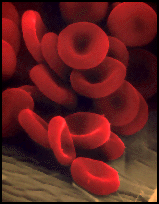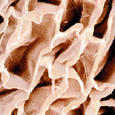| Formulation of the Cell
Theory (An anecdotal History)
In 1838,
Theodor Schwann and
Matthias Schleiden were enjoying
after-dinner coffee and talking about their studies on
cells. It has been suggested that when Schwann heard Schleiden describe plant cells
with nuclei, he was struck by the similarity of these
plant cells to cells he had observed in animal tissues.
The two scientists went immediately to Schwann's lab to look at his
slides. In 1838, Schleiden
published "Beiträge zur Phytogenesis"
(Contributions to Our Knowledge of Phytogenesis). The
article outlined his theories of the roles cells played
as plants developed. Schwann
published his book on animal and plant cells (Schwann
1839) the next year, a treatise devoid of
acknowledgments of anyone else's contribution, including
that of Schleiden (1838).
He summarized his observations into three conclusions
about cells:
1) The
cell is the unit of structure, physiology, and
organization in living things.
2) The
cell retains a dual existence as a distinct entity and a
building block in the
construction of organisms.
3)
Cells form by free-cell formation, similar to the
formation of crystals (spontaneous generation).
We know today
that the first two tenets are correct, but the third is
clearly wrong. The correct interpretation of cell
formation by division was finally promoted by others and
formally enunciated in Rudolph
Virchow's powerful dictum, "Omnis cellula e cellula"...
"All cells only arise from
pre-existing cells".
Back or
next
- modern tenets of Cell Theory & 1st microscopes
|
|
In 1663 an
English scientist, Robert Hooke, discovered cells in
a piece of cork, which he examined under his
primitive microscope (figures).
Actually, Hooke only observed cell walls because
cork cells are dead and without cytoplasmic
contents. Hooke drew the cells he saw and also
coined the word CELL.
The word cell is derived from the Latin word 'cellula' which means
small compartment. Hooke published his findings in
his famous work, Micrographia:
Physiological Descriptions of Minute
Bodies made by Magnifying Glasses (1665).
Ten years later Anton van Leeuwenhoek
(1632-1723), a Dutch businessman and a contemporary of
Hooke used his own
(single lens) monocular microscopes and was the first
person to observe bacteria
and protozoa. Leeuwenhoek is known to have
made over 500 "microscopes," of which fewer than ten
have survived to the present day. In basic design,
probably all of Leeuwenhoek's instruments were simply
powerful magnifying glasses, not compound microscopes
of the type used today. Leeuwenhoek's
skill at grinding lenses, together with his naturally
acute eyesight and great care in adjusting the
lighting where he worked, enabled him to build
microscopes that magnified over 200 times, with
clearer and brighter images than any of his colleagues
at that time. In 1673,
Leeuwenhoek began writing letters to the
newly formed Royal
Society of London, describing what he
had seen with his lenses. His first letter contained
some observations on the stings of bees. For the next
fifty years he corresponded with the Royal Society.
His observations, written in Dutch, were translated
into English or Latin and printed in journals as Transactions
of the Royal Society. Leeuwenhoek
looked at animal and plant tissues, at mineral
crystals, and at fossils. He was the first to see
microscopic single celled protists with shells, the foraminifera,
which he described as "little cockles. . . no bigger
than a coarse sand-grain." He discovered blood
cells, and was the first to see living sperm cells of
animals. He discovered microscopic animals such as nematodes (round worms) and rotifers.
The list of his discoveries is long. Leeuwenhoek soon became
famous as his letters were published and
translated. In 1680 he was elected a full member
of the Royal Society. After his death on August 30,
1723, a member of the Royal Society wrote... "Antony van Leeuwenhoek
considered that what is true in natural philosophy can
be most fruitfully investigated by the experimental
method, supported by the evidence of the senses; for
which reason, by diligence and tireless labor he made
with his own hand certain most excellent lenses, with
the aid of which he discovered many secrets of Nature,
now famous throughout the whole philosophical World".
No truer definition of the scientific method may be
found.
next -
discovery of cell nucleus
Around 1833 Robert Brown reported the
discovery of the nucleus. Brown
was a naturalist who visited the "colonies of Australia"
from 1801 through 1805, where he cataloged and described
over 1,700 new species of plants. Brown
was an accomplished technician and an extraordinarily
gifted observer of microscopic phenomena. It was Brown who identified the naked
ovule in the gymnospermae. This is a difficult
observation to make even with a modern instrument and
the benefit of hindsight. But it was with the
observation of the incessant agitation of minute
suspended particles that Brown's
name became inextricably linked. The effect, since
described as Brownian Motion, was
first noticed by him in 1827. Having worked on the
ovum, it was natural to direct attention to the
structure of pollen and its Brown
interrelationship with the pistil. In the course of his
microscopic studies of the epidermis of orchids,
discovered in these cells "an opaque spot," which he
named the nucleus.
Doubtless the same "spot" had been seen often enough
before by other observers, but Brown
was the first to recognize it as a component part of the
vegetable cell and to give it a name. This nucleus (or
areola as he called it) of the cell, was not confined to
the epidermis, being also found, in the pubescence of
the surface and in the parenchyma or internal cells of
the tissue. This nucleus of the cell was not confined to
only orchids, but was equally manifest in many other
monocotyledonous families and in the epidermis of
dicotyledonous plants, and even in the early stages of
development of the pollen. In some plants, as
Tradascantia virginica, it was uncommonly distinct,
especially in the tissue of the stigma, in the cells of
the ovum, even before impregnation, and in all stages of
formation of the grains of pollen .
It is upon the works of Hooke, Leeuwenhoek, Oken, and Brown that Schleiden and Schwann built their Cell Theory. It was the
German professor of botany at the University of
Jena, Dr. M. J. Schleiden,
who brought the nucleus to popular attention, and
to asserted its all-importance in the function of
a cell. Schleiden
freely acknowledged his indebtedness to Brown for first knowledge
of the nucleus, but he soon carried out his own
observations of the nucleus, far beyond those of Brown. He came to believe
that the nucleus is really the most important
portion of the cell, in that it is the original
structure from which the remainder of the cell is
developed. He called it the cytoblast.
He outlined his views in an epochal paper
published in Muller's Archives in 1838, under
title of "Beitrage zur Phytogenesis." This paper
is in itself of value, yet the most important
outgrowth of Schleiden's observations of the
nucleus did not spring from his own labors, but
from those of a friend to whom he mentioned his
discoveries the year previous to their
publication. This friend was Dr. Theodor Schwann,
professor of physiology in the University of
Louvain.
next
- Schwann and Schleiden observations.
|
|
Schwann was puzzling over
certain details of animal histology, which he
could not clearly explain. He had noted a strange
resemblance of embryonic cord material, from which
the spinal column develops, to vegetable cells. Schwann recognized a
cell-like character of certain animal tissues. Schwann felt that this
similarity could not be mere coincidence, and it
seemed to fit when Schleiden
called his attention to the nucleus. Then he
reasoned that if there really is the
correspondence between vegetable and animal
tissues that he suspected, and if the nucleus is
so important in the vegetable cell, as Schleiden believed, the
nucleus should also be found in the ultimate
particles of animal tissues. A closer study of
animal tissues under the microscope showed, in
particular in embryonic tissues, that the "opaque
spots" that Schleiden
described were found in abundance. The location of
these nuclei at comparatively regular intervals
suggested that they are found in definite
compartments of the tissue, as Schleiden had shown to be
the case with vegetables; indeed, the walls that
separated such cell-like compartments one from
another were in some cases visible. Soon Schwann was convinced
that his original premise was right, and that all
animal tissues are composed of cells not unlike
the cells of vegetables. Adopting the same
designation, Schwann
propounded what soon became famous as the CELL THEORY. So
expeditious was his observations that he
published a book early in 1839, only a few months
after the appearance of Schleiden's
paper.
Between 1680 and the early
1800's it appears that not much was accomplished in the
study of cell structure. This may be due to the lack of
quality lens for microscopes and the dedication to spend
long hours of detailed observation over what microscopes
existed at that time. Leeuwenhoek did not record his
methodology for grinding quality lenses and thus
microscopy suffered for over 100 years.
German natur-philosopher
and microscopist, Lorenz Oken
had been trained in medicine at Freiburg University. He
went on to become a renown philosopher and thinker of
the 19th century. It is reported that in 1805 Lorenz Oken stated that "All
organic beings originate from and consist of vesicles
or cells"... which may have been the first
statement of a cell theory .
back.
|




